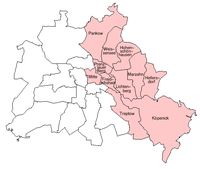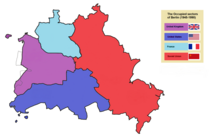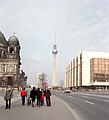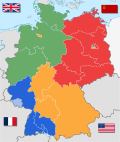You can help expand this article with text translated from the corresponding article in German. (July 2010) Click for important translation instructions.
|
| East BerlinOst-Berlin Berlin (Ost) Demokratischer Sektor von Berlin Berlin, Hauptstadt der DDR | |||||||||||
|---|---|---|---|---|---|---|---|---|---|---|---|
| 1948–1990 | |||||||||||
 Flag
Flag
 Coat of arms
Coat of arms
| |||||||||||
 East Berlin (red) within East Germany East Berlin (red) within East Germany | |||||||||||
| Status | Capital of East Germany | ||||||||||
| First Secretary | |||||||||||
| • 1948–1953 | Hans Jendretzky | ||||||||||
| • 1953–1957 | Alfred Neumann | ||||||||||
| • 1957–1959 | Hans Kiefert | ||||||||||
| • 1959–1971 | Paul Verner | ||||||||||
| • 1971–1985 | Konrad Naumann | ||||||||||
| • 1985–1989 | Günter Schabowski | ||||||||||
| • 1989–1990 | Heinz Albrecht | ||||||||||
| Lord Mayor | |||||||||||
| • 1948–1967 | Friedrich Ebert Jr. (SED) | ||||||||||
| • 1967–1974 | Herbert Fechner (SED) | ||||||||||
| • 1974–1990 | Erhard Krack (SED) | ||||||||||
| • 1990 | Ingrid Pankraz (PDS) | ||||||||||
| • 1990 | Christian Hartenhauer (PDS) | ||||||||||
| • 1990–1991 | Tino Schwierzina (SDP) | ||||||||||
| • 1991 | Thomas Krüger (SDP) | ||||||||||
| Historical era | Cold War | ||||||||||
| • Establishment of East Germany | 7 October 1948 | ||||||||||
| • Reunification | 3 October 1990 | ||||||||||
| Population | |||||||||||
| • 1946 | 1,174,582 | ||||||||||
| • 1961 | 1,055,283 | ||||||||||
| • 1989 | 1,279,212 | ||||||||||
| |||||||||||
| Today part of | Germany | ||||||||||
| Part of a series on the |
|---|
| History of Berlin |
 |
| Margraviate of Brandenburg (1157–1806) |
| Kingdom of Prussia (1701–1918) |
| German Empire (1871–1918) |
| Free State of Prussia (1918–1947) |
| Weimar Republic (1919–1933) |
| Nazi Germany (1933–1945) |
| West Germany and East Germany (1945–1990) |
|
| Federal Republic of Germany (1990–present) |
| See also |
East Berlin (German: Ost-Berlin; pronounced [ˈɔstbɛʁˌliːn] ) was the partially recognised capital of East Germany (GDR) from 1949 to 1990. From 1945, it was the Soviet occupation sector of Berlin. The American, British, and French sectors were known as West Berlin. From 13 August 1961 until 9 November 1989, East Berlin was separated from West Berlin by the Berlin Wall. The Western Allied powers did not recognize East Berlin as the GDR's capital, nor the GDR's authority to govern East Berlin. For most of its administrative existence, East Berlin was officially known as Berlin, capital of the GDR (German: Berlin, Hauptstadt der DDR) by the GDR government. On 3 October 1990, the day Germany was officially reunified, East and West Berlin formally reunited as the city of Berlin.
Overview
With the London Protocol of 1944 signed on 12 September 1944, the United States, the United Kingdom, and the Soviet Union decided to divide Germany into three occupation zones and to establish a special area of Berlin, which was occupied by the three Allied Forces together. In May 1945, the Soviet Union installed a city government for the whole city that was called "Magistrate of Greater Berlin", which existed until 1947. After the war, the Allied Forces initially administered the city together within the Allied Kommandatura, which served as the governing body of the city. However, in 1948 the Soviet representative left the Kommandatura and the common administration broke apart during the following months. In the Soviet sector, a separate city government was established, which continued to call itself the "Magistrate of Greater Berlin".
When the German Democratic Republic was established in 1949, it immediately claimed East Berlin as its capital—a claim that was recognized by all communist countries. Nevertheless, East Berlin's representatives to the Volkskammer were not directly elected and did not have full voting rights until 1981.
In June 1948, all railways and roads leading to West Berlin were blocked, and East Berliners were not allowed to emigrate. Nevertheless, more than 1,000 East Germans were escaping to West Berlin each day by 1960, caused by the strains on the East German economy from war reparations owed to the Soviet Union, massive destruction of industry, and lack of assistance from the Marshall Plan. In August 1961, the East German Government tried to stop the population exodus by separating West Berlin by the Berlin Wall. It was very dangerous for fleeing residents to cross because armed soldiers were trained to shoot illegal emigrants.
East Germany was a socialist republic. Eventually, Christian churches were allowed to operate without restraint after years of harassment by authorities. In the 1970s, the wages of East Berliners rose and working hours fell.
The Soviet Union and the Communist Bloc recognized East Berlin as the GDR's capital. However, Western Allies (the United States, United Kingdom, and France) never formally acknowledged the authority of the East German government to govern East Berlin. Official Allied protocol recognized only the authority of the Soviet Union in East Berlin in accordance with the occupation status of Berlin as a whole. The United States Command Berlin, for example, published detailed instructions for U.S. military and civilian personnel wishing to visit East Berlin. In fact, the three Western commandants regularly protested against the presence of the East German National People's Army in East Berlin, particularly on the occasion of military parades. Nevertheless, the three Western Allies eventually established embassies in East Berlin in the 1970s, although they never recognized it as the capital of East Germany. Treaties instead used terms such as "seat of government".
On 3 October 1990, East and West Germany and East and West Berlin were reunited, thus formally ending the existence of East Berlin. Citywide elections in December 1990 resulted in the first "all-Berlin" mayor being elected to take office in January 1991, with the separate offices of mayors in East and West Berlin expiring at the time, and Eberhard Diepgen (a former mayor of West Berlin) became the first elected mayor of a reunited Berlin.
Historical population
East Berlin reached its highest population in 1988 with 1.28 million. The lowest value was in 1961, the year the Berlin Wall was built, with under 1.06 million registered. The figures in the following table, unless otherwise indicated, are from the official central statistical office of East Germany.
|
|
East Berlin today
Since reunification, the German government has spent vast amounts of money on reintegrating the two halves of the city and bringing services and infrastructure in the former East Berlin up to the standard established in West Berlin.
After reunification, the East German economy suffered significantly. Under the adopted policy of privatization of state-owned firms under the auspices of the Treuhandanstalt, many East German factories were shut down—which also led to mass unemployment—due to gaps in productivity with and investment compared to West German companies, as well as an inability to comply with West German pollution and safety standards in a way that was deemed cost-effective. Because of this, a massive amount of West German economic aid was poured into East Germany to revitalize it. This stimulus was part-funded through a 7.5% tax on income for individuals and companies (in addition to normal income tax or company tax) known as the Solidaritätszuschlaggesetz (SolZG) or "solidarity surcharge", which though only in effect for 1991–1992 (later reintroduced in 1995 at 7.5 and then dropped down to 5.5% in 1998 and continues to be levied to this day) led to a great deal of resentment toward the East Germans.
Despite the large sums of economic aid poured into East Berlin, there still remain obvious differences between the former East and West Berlins. East Berlin has a distinct visual style; this is partly due to the greater survival of prewar façades and streetscapes, with some still showing signs of wartime damage. The unique look of Socialist Classicism that was used in East Berlin (along with the rest of the former GDR) also contrasts markedly with the urban development styles employed in the former West Berlin. Additionally, the former East Berlin (along with the rest of the former GDR) retains a small number of its GDR-era street and place names commemorating German socialist heroes, such as Karl-Marx-Allee, Rosa-Luxemburg-Platz, and Karl-Liebknecht-Straße. Many such names, however, were deemed inappropriate (for various reasons) and, through decommunization, changed after a long process of review (so, for instance, Leninallee reverted to Landsberger Allee in 1991, and Dimitroffstraße reverted to Danziger Straße in 1995).
Another symbolic icon of the former East Berlin (and of East Germany as a whole) is the Ampelmännchen (tr. "little traffic light men"), a stylized version of a fedora-wearing man crossing the street, which is found on traffic lights at many pedestrian crosswalks throughout the former East. Following a civic debate about whether the Ampelmännchen should be abolished or disseminated more widely (due to concerns of consistency), several crosswalks in some parts of the former West Berlin began to employ the Ampelmännchen.
Twenty-five years after the two cities were reunified, the people of East and West Berlin still had noticeable differences between them, and these differences became more apparent among the older generations. The two groups also had sometimes-derogatory slang terms to refer to each other. A former East Berliner (or East German) was known as an "Ossi" (from the German word for east, Ost), and a former West Berliner (or West German) was known as a "Wessi" (from the German word for west, West). Both sides also engaged in stereotyping the other. A stereotypical Ossi had little ambition or poor work ethic and was chronically bitter, while a stereotypical Wessi was arrogant, selfish, impatient and pushy.
Boroughs

At the time of German reunification, East Berlin comprised the boroughs of
- Friedrichshain
- Hellersdorf (since 1986)
- Hohenschönhausen (since 1985)
- Köpenick
- Lichtenberg
- Marzahn (since 1979)
- Mitte
- Pankow
- Prenzlauer Berg
- Treptow
- Weißensee

Images
-
 Marx-Engels-Platz and the Palace of the Republic in East Berlin in the summer of 1989. The Fernsehturm (TV Tower) is visible in the background
Marx-Engels-Platz and the Palace of the Republic in East Berlin in the summer of 1989. The Fernsehturm (TV Tower) is visible in the background
-
 Easter Sunday, 1988, Fernsehturm and Palace of the Republic
Easter Sunday, 1988, Fernsehturm and Palace of the Republic
-
 Karl-Marx-Allee apartments
Karl-Marx-Allee apartments
-
Wall plaque of Lenin, off Wilhelmstrasse
-
GDR-era mural of Meissen porcelain on former Council of Ministers building, facing Leipziger Straße
-
The Soviet War Memorial in Treptower Park
-
Cafe Moskau in Karl-Marx-Allee
-
The Palace of the Republic, being dismantled
-
New Synagogue, Oranienburger Straße
-
 "Hochhaus" in Weberwiese, the first high rise apartment built after the war
"Hochhaus" in Weberwiese, the first high rise apartment built after the war
-
Volksbühne, Rosa-Luxemburg-Platz
-
 Late-1980s GDR apartment blocks on the Wilhelmstrasse
Late-1980s GDR apartment blocks on the Wilhelmstrasse
-
 Strausberger Platz with constructivism style building
Strausberger Platz with constructivism style building
-
Proletarian hero, Alexanderplatz
-
 Gerhard Behrendt with Sandmännchen. The show was recorded in East Berlin
Gerhard Behrendt with Sandmännchen. The show was recorded in East Berlin
-
 The Bode Museum at the northern end of the Museum Island, 1956
The Bode Museum at the northern end of the Museum Island, 1956
-
 Haus der Schweiz [de], Unter der Linden at FriedrichStrasse, East Berlin, February 1975
Haus der Schweiz [de], Unter der Linden at FriedrichStrasse, East Berlin, February 1975
-
Statues of Marx and Engels, Marx-Engels-Forum
See also
- West Berlin
- Bonn, the West German capital city
Further reading
- Durie, William (2012). The British Garrison Berlin 1945 - 1994: nowhere to go ... a pictorial historiography of the British Military occupation / presence in Berlin. Berlin: Vergangenheitsverlag (de). ISBN 978-3-86408-068-5. OCLC 978161722.
Notes
- Partially recognised; seen by the Western Bloc as the Soviet-occupied portion of Berlin
References
- Knowles, Chris (29 January 2014). "Germany 1945-1949: a case study in post-conflict reconstruction". History & Policy. History & Policy. Retrieved 19 July 2016.
- Peitsch, Helmut; Williams, Rhys, eds. (1989). Berlin seit dem Kriegsende [Berlin Since War's End] (in German). Manchester University Press. p. 18. ISBN 9780719026683.
- ^ Stein, R. Conrad (1997). Berlin. Children's Press. p. 29. ISBN 9780516205823.
- ^ Grant, R. G. (1999). The Berlin Wall. Raintree Steck-Vaughn. ISBN 9780817250171.
- "Helpful Hints for US Visitors to East Berlin" (PDF). Headquarters, U.S. Command Berlin. 9 November 1981. Archived (PDF) from the original on 5 March 2023.
- Pugh, Emily (2014). Architecture, Politics, and Identity in Divided Berlin. University of Pittsburgh Press. p. 159. ISBN 9780822979579.
- Kinzer, Stephen (1 December 1990). "Berlin Mayoral Contest Has Many Uncertainties". The New York Times. ISSN 0362-4331. Retrieved 4 January 2023.
- "BZSt - Tax withholding amount". www.bzst.de. Federal Central Tax Office. Archived from the original on 15 October 2019. Retrieved 15 October 2019.
- "Company Tax in the EU- Germany". Your Europe - Business. European Union. Archived from the original on 3 October 2018. Retrieved 15 October 2019.
External links
- My First Time to East Berlin, 11 November 2019, James Bovard, Mises Institute
| Allied-occupied Germany (1945–1949/1956/1990) | ||
|---|---|---|
| American Zone |  | |
| British Zone | ||
| French Zone | ||
| Soviet Zone | ||
| Berlin (1949–1990) |
| |
| Administrative divisions of the German Democratic Republic (1949–90) | ||
|---|---|---|
| Bezirke (1952–90) |  | |
| States (1949–52; 1990) | ||
